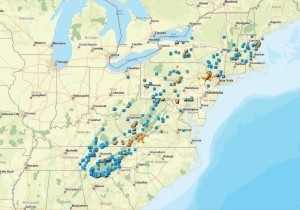
For such a tiny creature, hemlock woolly adelgid (HWA) can cause a remarkable amount of devastation. This non-native, aphidlike insect sucks the nutrients out of hemlock trees, and – because of its abundant reproduction – can kill trees quickly. In the southern Appalachians, eastern hemlocks may die within only three years of infestation. In the Northeast, infestations tend not to kill trees as immediately, but factors such as additional pests, drought, and climate change can lead to quicker tree mortality. A loss of hemlock in our forests is of great concern for both ecological and economic reasons.
One of the most effective known ways to control HWA is the use of insecticides, but this is not feasible for managing forests. Another approach is through releases of Laricobius nigrinus, a tiny, predatory beetle that emerges from the soil in autumn. Both the adult beetle and its larvae feed on HWA and consume adelgid eggs, nymphs, and adults. L. nigrinus (Ln) is a northwestern species, and one of only three “Lari” species native to North America, all of which feed exclusively on adelgids. Only Ln, however, appears to be a significant predator of HWA.
For almost 20 years, state forestry agencies from Georgia to Maine have made autumn releases of Ln. To date, agencies in Vermont, New Hampshire, Maine, and Massachusetts have released a combined total of approximately 30,000 Ln beetles in the Northeast, and these efforts are escalating. The New York State Hemlock Initiative (NYSHI) at Cornell University – a project that conducts research on HWA bio-controls – reared and released more than 10,500 Ln beetles last year alone.
Outside of the Cornell effort, the main source for Northeast-released Ln beetles is a lab at Virginia Tech, with funding provided by the USDA Forest Service. Some states are also establishing field insectaries or hand collecting beetles in other states. A field insectary is a designated area with a group of infested trees where beetles are reproducing well and can be collected for release in other areas.
Last year, states including New Hampshire, Connecticut, Massachusetts, New York, and Maine also began releasing a second Lari species in the Northeast, Laricobius osakensis (Lo). (The first releases on the East Coast occurred in 2012 in Virginia and West Virginia.) This beetle, like HWA, is native to Japan – and has been cleared by USDA for release as a biocontrol in the United States. Studies suggest that Lo may be more successful at controlling HWA than Ln, but more research is needed.
Both Ln and Lo continue to be recovered in areas where they are released – sometimes many miles from the original release site – indicating that they are reproducing and spreading on their own. Although Lari’s impacts on hemlock stand health are not yet understood, a recent study by Virginia Tech suggests that Lari predation of HWA improves hemlock branch health. Total control of HWA by Lari alone is unlikely, however, and HWA is continuing to spread. One of the limitations of Lari as a biocontrol is that its life cycle is not completely in sync with its prey. HWA has two overlapping generations per year; one that occurs early to late spring and one that occurs from late spring through early spring of the following year. Adult Lari beetles feed throughout the winter months, lay eggs and then die in the spring. Their developing larvae feed on HWA eggs and fall to the ground to pupate, emerging as adults in autumn. This means that Lari isn’t available to prey on HWA during the summer months, and during this time, the adelgid population rebounds.
Lari is not the first beetle that’s been released as a biocontrol for HWA in North America. Sasajiscymnus tsugae (St) – a lady beetle native to Japan – was first released in Connecticut in 1995. Easier to rear than Ln, and preying on both generations of HWA, St is the only HWA predator currently available commercially in the United States. However, while states have released much higher numbers of St (more than 3 million beetles), recoveries are inconsistent and much lower than Ln, and there is no evidence that St is successful at reducing HWA populations.
The next contender in the fight against HWA is a predatory fly. In addition to raising both Lari species, NYSHI is also rearing and releasing two species of silver flies: Leucotaraxis argenticollis and Leucotaraxis piniperda. These new predators have the potential to have greater impact because they emerge in spring and prey on both generations of HWA. Leucotaraxis species are good fliers, which has made recovery difficult, but collections at release sites in Virginia this summer indicate the species is establishing. Although HWA is difficult to contain, and biocontrol species may take years to have widespread impacts (as well as raising concerns of unintended consequences that come with any biocontrol species release), these efforts may give hemlocks a fighting chance.
This past June, the Vermont Department of Forests, Parks & Recreation; The University of Vermont Extension; Vermont Department of Fish & Wildlife; and Atowi Project released a new publication, Management Guide for Eastern Hemlock Conservation in Vermont. This comprehensive guide includes information that’s useful for forest managers throughout the Northeast, including a review of threats to hemlock health and featuring a rogues’ gallery of non-native insects and fungi in our region that feed on hemlocks. The guide also describes control and management options.
For updated information on the NYSHI lab at Cornell University, click here.



